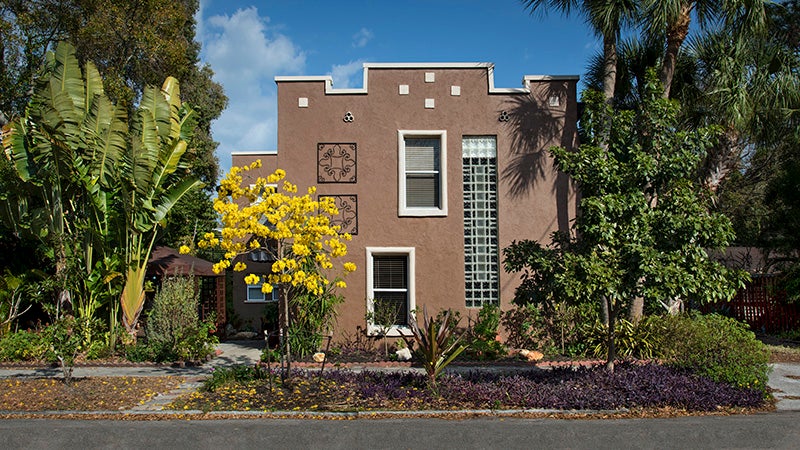What are colonial-style homes?

American colonial style in architecture refers to the era before the United States was born, when emigrants from Europe began settling on the North American continent. Since the period was a long one — spanning 100 years — “colonial style” actually encompasses a few different styles and designs. And there are different regional touches, reflecting the local climate and the influences of the settlers’ native countries.
Overall, though, American colonial style is characterized by a simple elegance and symmetrical, two-story layout. Found throughout the country today, they are many people’s idea of a quintessential traditional home.
History of colonial style
The original American colonial-style homes were built throughout the 17th and 18th centuries. Style-wise, they are “based on British homes with an emphasis on functionally serving the needs of a family and withstanding harsh climates,” says Tony Mariotti, CEO and founder of RubyHome, a luxury real estate brokerage in Los Angeles.
Since labor was limited and these homes had to be built quickly, they tended to be relatively easy to construct: a rectangular foundation with clean roof lines, one uniform window size and limited ornamentation. But they were also built with an eye to the future: It became common to add extra rooms and stories as families grew in size and wealth.
As immigrants came to the colonies from other countries, they introduced new styles reminiscent of homes in their birthplace. These other styles incorporated new elements, like the gambrel roof (a two-sided roof with two slopes on each side) typical of Dutch architecture, but still kept the characteristic functionality and symmetrical, squarish silhouette.
Colonial-style homes briefly fell out of popularity in the first half of the 19th century in favor of more ornate Victorian-style homes. But they experienced a revival in the 1880s, sparked by the celebrations of the American Centennial in 1876.
That revival has never really ended, but endured throughout the country for most of the last 140 years. Still, colonial-style homes have been adjusted to best suit their local habitat. “In California, the American Colonial style was substituted by Spanish Colonial Revival and Mediterranean homes, which are more suitable for warmer climates,” says Mariotti.
What makes a house colonial style?
Balance and symmetry are characteristics of both the interior and exterior of most colonial homes. There are minimal decorative elements. While simple, the silhouette is a wide, expansive one, reflecting the abundance of land and open space that marked the settlers’ new continent.
External features
American Colonial homes are generally characterized by a square or rectangular facade, a central entrance and windows symmetrically placed on either side of the entrance. They are typically made of wood, stone or brick and will generally have uniformly sized doors and windows with shutters. The roof is typically side-gabled and dormers are common.
Colonial-style homes tend to have several stories. They usually place bedrooms upstairs with the main floor made up of multiple living spaces and places for the family to gather.
Internal features
Colonial homes will typically have a “central staircase combined with a foyer adjacent to the entry and a living or dining area at the rear,” says architect Michael Bergin, VP of Platform and co-founder of Higharc, a home automation building platform. Originally, they featured “a large fireplace at each end of the home to maximize heating bedrooms and living areas,” adds Bergin. Built in the days before central heating and cooling systems, they would be laid out to retain warmth in winter and capture cross breezes in summer — a passive sort of HVAC now in vogue in contemporary eco-friendly homes.
Varieties of colonial style
Georgian

Early American/Saltbox

New England/Cape Cod

French

Dutch/German

Spanish

Federalist

What is Colonial Revival style?
The Centennial International Exhibition of 1876, held in Philadelphia, renewed Americans’ interest in their pre-independence past. As part of the celebration of their country turning 100, a vogue for century-old styles began to permeate fashions, decorative arts and architecture.
Colonial Revival homes, built in the latter decades of the 19th century, take elements of the original style but are typically much bigger than the ones built during the actual colonial period. They are more ornate, too: Colonial Revival homes typically have more complex roof lines and more ornamentation like fan windows and columns. And of course, they took advantage of contemporary building materials and heating methods.
Buying a colonial-style house
There are several pros and cons to the colonial style to consider.
Pros
- Authentic colonial homes allow you to own a part of history.
- Colonial homes are “easy to decorate and look surprisingly good when decorated with contemporary and modern furniture. However, they are incredibly cozy when decorated with antiques and period pieces,” says Mariotti.
- Traditional colonial homes were built to withstand harsh climates and may be cheaper to heat in the winter than other historic houses.
Cons
- “A historic colonial home needs to be inspected for proper maintenance with special concern for the framing. Foundations built at that time did not have steel reinforcement, so they are often at risk of falling apart,” says Bergin.
- “If the roof of an American or Dutch Colonial home still has a shake roof, the buyer will have a hard time finding homeowners insurance. Wood roofs are very flammable, and new homeowners must replace them immediately to qualify for insurance,” says Mariotti.
- Multiple-story layout might not be ideal for the elderly or disabled.
What do colonial houses cost?
Colonial-style homes have been built semi-continuously for the last 300+ years. The price you pay for one will vary drastically, depending on whether it’s a landmarked historic home, an inner city fixer-upper, or a custom-built colonial-style home.
A five-year-old new colonial-style in an affluent neighborhood will cost more to purchase but less to maintain than a 300-year-old Colonial in rural Maine.
The cost to build a colonial-style house depends on your location, the size of the house,and the features you want. HomeAdvisor estimates that the cost to build a 3,000-square-foot Colonial would vary from $300,000 to $600,000, but high cost of living areas can expect to pay significantly more for labor and the cost of the land to build on. “All-in construction for a colonial home around 3,000 feet can easily run to $3 million dollars in the Bay Area,” says Bergin.
Final word on colonial-style homes
Originating on the Eastern Seaboard, colonial-style homes can be found throughout the U.S. today. Colonial-style homes are likely to remain a common home style with some variation for the foreseeable future. The simple construction, endless options for additions, and emphasis on clean lines make them timeless, and a classic American style.
Why we ask for feedback Your feedback helps us improve our content and services. It takes less than a minute to complete.
Your responses are anonymous and will only be used for improving our website.






